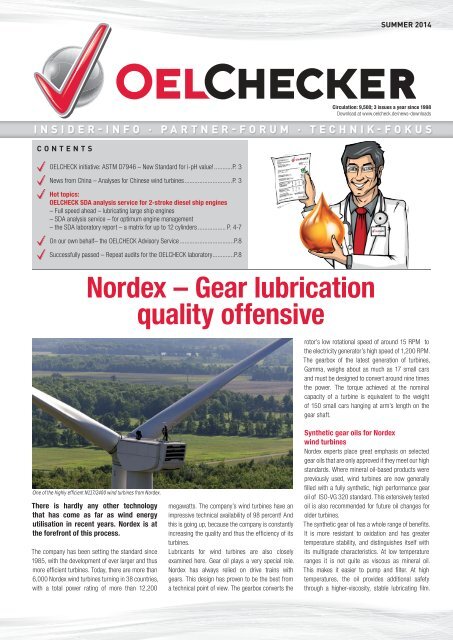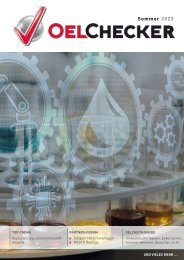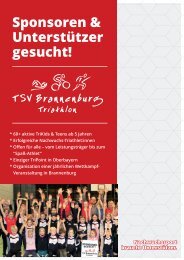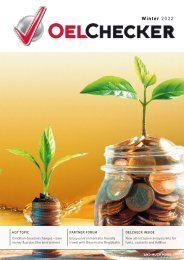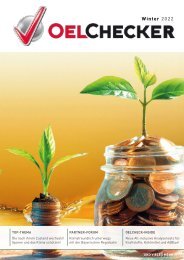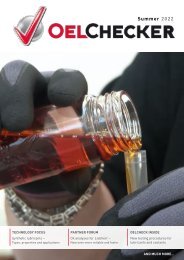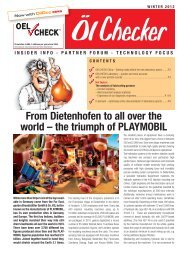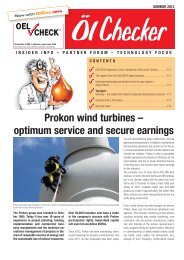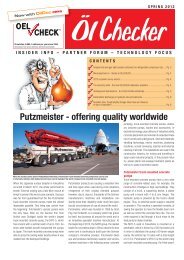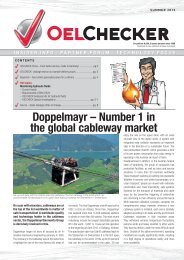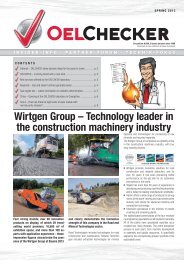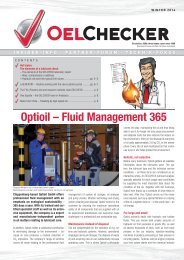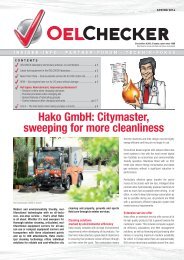OELCHECKER - Summer 2014
> Nordex – Gear lubrication quality offensive > OELCHECK initiative: ASTM D7946 – New Standard for i-pH value! > News from China – Analyses for Chinese wind turbines > Hot Topics: OELCHECK SDA analysis service for 2-stroke diesel ship engines > Full speed ahead – lubricating large ship engines > SDA analysis service – for optimum engine management > The SDA laboratory report – a matrix for up to 12 cylinders > On our own behalf – the OELCHECK Advisory Service > Successfully passed – Repeat audits for the OELCHECK laboratory
> Nordex – Gear lubrication quality offensive
> OELCHECK initiative: ASTM D7946 – New Standard for i-pH value!
> News from China – Analyses for Chinese wind turbines
> Hot Topics: OELCHECK SDA analysis service for 2-stroke diesel ship engines
> Full speed ahead – lubricating large ship engines
> SDA analysis service – for optimum engine management
> The SDA laboratory report – a matrix for up to 12 cylinders
> On our own behalf – the OELCHECK Advisory Service
> Successfully passed – Repeat audits for the OELCHECK laboratory
- No tags were found...
Create successful ePaper yourself
Turn your PDF publications into a flip-book with our unique Google optimized e-Paper software.
SUMMER <strong>2014</strong><br />
Circulation: 9,500; 3 issues a year since 1998<br />
Download at www.oelcheck.de/news-downloads<br />
CONTENTS<br />
OELCHECK initiative: ASTM D7946 – New Standard for i-pH value! ...........P. 3<br />
News from China – Analyses for Chinese wind turbines .............................P. 3<br />
Hot topics:<br />
OELCHECK SDA analysis service for 2-stroke diesel ship engines<br />
– Full speed ahead – lubricating large ship engines<br />
– SDA analysis service – for optimum engine management<br />
– the SDA laboratory report – a matrix for up to 12 cylinders ................. P. 4-7<br />
On our own behalf– the OELCHECK Advisory Service .................................P.8<br />
Successfully passed – Repeat audits for the OELCHECK laboratory .............P.8<br />
Nordex – Gear lubrication<br />
quality offensive<br />
rotor’s low rotational speed of around 15 RPM to<br />
the electricity generator’s high speed of 1,200 RPM.<br />
The gearbox of the latest generation of turbines,<br />
Gamma, weighs about as much as 17 small cars<br />
and must be designed to convert around nine times<br />
the power. The torque achieved at the nominal<br />
capacity of a turbine is equivalent to the weight<br />
of 150 small cars hanging at arm’s length on the<br />
gear shaft.<br />
One of the highly effi cient N117/2400 wind turbines from Nordex.<br />
There is hardly any other technology<br />
that has come as far as wind energy<br />
utilisation in recent years. Nordex is at<br />
the forefront of this process.<br />
The company has been setting the standard since<br />
1985, with the development of ever larger and thus<br />
more efficient turbines. Today, there are more than<br />
6,000 Nordex wind turbines turning in 38 countries,<br />
with a total power rating of more than 12,200<br />
megawatts. The company’s wind turbines have an<br />
impressive technical availability of 98 percent! And<br />
this is going up, because the company is constantly<br />
increasing the quality and thus the efficiency of its<br />
turbines.<br />
Lubricants for wind turbines are also closely<br />
examined here. Gear oil plays a very special role.<br />
Nordex has always relied on drive trains with<br />
gears. This design has proven to be the best from<br />
a technical point of view. The gearbox converts the<br />
Synthetic gear oils for Nordex<br />
wind turbines<br />
Nordex experts place great emphasis on selected<br />
gear oils that are only approved if they meet our high<br />
standards. Where mineral oil-based products were<br />
previously used, wind turbines are now generally<br />
filled with a fully synthetic, high performance gear<br />
oil of ISO-VG 320 standard. This extensively tested<br />
oil is also recommended for future oil changes for<br />
older turbines.<br />
The synthetic gear oil has a whole range of benefits.<br />
It is more resistant to oxidation and has greater<br />
temperature stability, and distinguishes itself with<br />
its multigrade characteristics. At low temperature<br />
ranges it is not quite as viscous as mineral oil.<br />
This makes it easier to pump and filter. At high<br />
temperatures, the oil provides additional safety<br />
through a higher-viscosity, stable lubricating film.
OELCHECK GmbH has been certified in accordance with<br />
DIN EN ISO 9001 and 14001 for almost 20 years. All<br />
major testing methods are accredited in accordance with<br />
DIN EN ISO 17025. Our high quality standards extend to every area of<br />
the company. The OELCHECK team puts these standards into practice<br />
daily. But better is the enemy of good! And repeat audits after<br />
3 to 5 years are a must, with annual control audits. In summer <strong>2014</strong><br />
we successfully passed three of these repeat audits. Even though<br />
they take a lot of work, the input and suggestions for improvement by<br />
the auditors in cooperation with our employees are worth the effort.<br />
We are also already planning a further „audit“, one that is just<br />
as important for our customers and for us. Although there is no standard for this just yet,<br />
we want to perform another large-scale survey of our 15,000 plus customers later in the<br />
year. We know that we will get back valuable suggestions this time too. When we performed our last<br />
survey in 2012, we received suggestions to expand the customer portal www.laborberichte.com. We<br />
are currently revising its design and enhancing its features to make your work and our work easier.<br />
For example, it will be possible to enter new test data directly on-site using smartphones. The sample<br />
shipping form no longer needs to be completed, since by reading the QR code of the previous sample,<br />
the data appears immediately on the display. This saves time, reduces transmission errors and makes<br />
working life just that little bit easier! – It’s going to take a little longer yet, but you can start looking<br />
forward with us to the new and expanded OELCHECK customer portal!<br />
Yours, Barbara ra Weismann<br />
n<br />
cooling circuit for the oil is thoroughly rinsed. The<br />
oil that is not drained into reservoirs in bearings<br />
and ribbing is sucked out using special lances.<br />
The fresh synthetic oil then used to fill the turbine<br />
should not contain any more than 3% of the old<br />
mineral oil. Synthetic oil can also only perform to<br />
its maximum potential if it is unmixed. On the other<br />
hand, the more powerful cleaning effect of the<br />
synthetic oil could dissolve any sludge deposits that<br />
the mineral oil could not remove. However, if these<br />
sludge deposits do enter the overall lubrication<br />
system with the oil, the filters will be able to block<br />
them more quickly. In a worst case scenario, the<br />
lubricant supply lines in the bearings can be<br />
blocked by deposits, causing bearing failures and<br />
then gear damage.<br />
So that operators are absolutely on the safe side,<br />
Nordex requires written proof in the form of a<br />
laboratory report that the requirement of less than<br />
3% residual oil has been adhered to when the oil<br />
is changed. This is easy to do using the analysis<br />
sets designed by OELCHECK specifically for Nordex<br />
wind turbines. The proven Nordex analysis sets<br />
have been a permanent fixture in our maintenance<br />
concept for years. Before a turbine converted to the<br />
new synthetic gear oil re-enters operation, a „zero<br />
sample“ is sent to OELCHECK. For this, „Oil change“<br />
is simply ticked on the shipping note.<br />
2<br />
A special anti-wear additive significantly exceeds<br />
the performance of traditional EP-additives. The<br />
special additive technology is activated at high,<br />
specific surface pressures and corresponding<br />
temperatures in particular. It delivers optimisation<br />
of friction partner surfaces and actively protects<br />
against wear. Together with the more favourable<br />
viscosity-temperature relationship, this achieves an<br />
improvement in gear efficiency. But that isn’t the<br />
only benefit for turbine operators.<br />
The synthetic lubricant achieves considerably<br />
greater durability than mineral oil based products.<br />
While, in the experience of Nordex, a mineral oilbased<br />
gear oil needs to be changed after 2 1/2 to<br />
no more than 3 years, the synthetic lubricant is not<br />
expected to be changed until after at least 5 years.<br />
With a capacity of 400-650 litres, this effect of<br />
the synthetic oil definitely pays for itself despite its<br />
slightly higher cost for the operator. Consequently,<br />
this results in lower costs for gear<br />
oil, maintenance and disposal.<br />
Gamma 3D model<br />
Safe conversion with<br />
oil analyses<br />
A wind turbine filled with mineral oil-based gear<br />
oil is primarily converted to the new synthetic<br />
gear oil when maintenance or a regular oil<br />
change is due. However, if irregular values<br />
are found for a gear oil during a half-yearly<br />
OIL CHECK, the turbine can certainly be converted<br />
to synthetic oil early. This is particularly the case<br />
where the lubricant has aged prematurely and<br />
oxidation and additive degeneration, amongst other<br />
things, are seen on the IR spectrum.<br />
Selected service companies that also perform<br />
maintenance on turbines in various wind farms<br />
carry out the conversion to the new synthetic<br />
gear oil. They carry out the work precisely to the<br />
specifications of Nordex. After draining the used<br />
oil at operating temperature, the gearbox and the<br />
Visit OELCHECK in hall B2, booth 306!<br />
Then, in the OELCHECK laboratory, values such<br />
as viscosity, wear, impurities and additives are<br />
determined, but not only these. As well as specific<br />
wave number ranges in the IR spectrum, the residual<br />
content of the previously used product in the fresh<br />
oil can also be determined precisely, amongst other<br />
things, by using its density. If it is under the limit of<br />
3% and everything else is in order, the go-ahead is<br />
given for the further operation of the Nordex wind<br />
turbine, which will be more efficient thanks to the<br />
new synthetic gear oil.<br />
Nordex – We’ve got the power<br />
Nordex, with its headquarters in Hamburg and its main<br />
production site in Rostock, is one of the world’s leading<br />
manufacturers of on-shore wind turbines. The company’s<br />
areas of expertise include developing and manufacturing<br />
wind turbines, constructing ready to use wind farms and<br />
maintenance and service. With its Delta generation, Nordex<br />
is offering the fourth generation of its proven multi-megawatt<br />
platform. With larger rotors, an increased power rating and<br />
optimised technical systems, the Delta generation sets new<br />
standards in terms of cost, reliability, ease of service and<br />
work safety.<br />
Further information: www.nordex-online.com
OELCHECK INSIDER INFO<br />
OELCHECK initiative: ASTM D7946 – New Standard for i-pH value!<br />
OELCHECK initiated a project at the ASTM<br />
(American Society for Testing and Materials)<br />
back in the summer of 2011 to standardise<br />
i-pH measurements and has assumed responsibility<br />
for this project at a technical level.<br />
In June <strong>2014</strong>, the approximately 50 members<br />
of the titration work group decided to adopt<br />
the new internationally applicable ASTM<br />
standard. Using the standardised method,<br />
the values previously calculated using different<br />
methods can finally be compared!<br />
The i-pH value (initial pH value or starting pH value) is<br />
the third important parameter along with AN (acidity<br />
number) and BN (base number), particularly for evaluating<br />
oils from biogas engines. While AN and BN<br />
both only provide information on the overall content<br />
of acidic or alkaline compounds, the i-pH value also<br />
allows acidity to be assessed. It can even be used to<br />
discover small quantities of strong and thus corrosive<br />
acids in oil, even if the AN, i.e. the total content of<br />
acidic compounds has not yet increased significantly.<br />
Because it provides this crucial piece of information,<br />
the i-pH is included in many limit and threshold<br />
tables by engine manufacturers and insurance<br />
companies. No standardised method had previously<br />
existed for determining this. Moreover, the method<br />
has been modified in many laboratories over the<br />
years. The values could previously only be compared<br />
to a limited extent, often making it difficult to decide<br />
whether used oil could continue to be used.<br />
A drat was firstly prepared for the new standard, in<br />
which sample weights of oil and solvent, measuring<br />
electrodes, measuring times and termination criteria<br />
were established. The suitability of the method<br />
was proven with an interlaboratory test. OELCHECK<br />
took eleven samples for this purpose, which had to<br />
cover the entire range from fresh oil to extremely<br />
aged oil, which was organised by engine operators.<br />
Furthermore, eleven laboratories had to be enlisted<br />
to participate in the interlaboratory test. The large<br />
number of samples and laboratories was the essential<br />
prerequisite in order to provide a solid statistical<br />
foundation for the results.<br />
After the interlaboratory test, a research report<br />
was produced, containing the precision data<br />
(repeatability, reproducibility) of the future standard.<br />
During fine-tuning, valuable comments were again<br />
received on how to improve the method.<br />
The adoption of the new standard marked the<br />
successful completion of a labour-intensive chapter.<br />
And, OELCHECK is already committing to its next<br />
project! Both at the ASTM and in a DIN standards<br />
work group, chaired by the Scientific Director<br />
of OELCHECK, Dr. Fischer, we are working on<br />
standardising titrations of the AN and BN with<br />
determination of thermometric end-point. In<br />
„Working Committee 663 Used Oil Testing“, too,<br />
OELCHECK is responsible for the „titrations“ group.<br />
An interlaboratory test is currently being evaluated.<br />
在 做 什 么 NEWS FROM CHINA 在 做 什 么<br />
It is hard to imagine a service technician living<br />
on a wind farm in the Western world, but<br />
for many of their Chinese colleagues, it is not<br />
at all unusual. They perform maintenance on<br />
wind turbines and also live where they work.<br />
Such commitment is admirable, but also necessary.<br />
China is the world’s largest producer of wind power,<br />
ahead of the USA and Germany. However, maintenance<br />
of the Chinese turbines is still in its infancy<br />
and remains far too cost-intensive. Defects in maintenance<br />
and operation currently reduce yields by<br />
15-30%. There is an urgent need for action here!<br />
China is aiming to achieve an installed output of<br />
200 GW (the equivalent of around 75 nuclear power<br />
plants) by 2020. Off-shore turbines are likely to<br />
contribute significantly towards this goal. The goals<br />
are ambitious, and the rapid development is already<br />
presenting major challenges. Many of the 90,000<br />
or so existing wind turbines are installed in the<br />
north, in areas that are difficult to reach and subject<br />
to extreme temperatures. A large proportion of the<br />
wind turbines were only produced in the last seven<br />
years. The mostly young domestic producers still<br />
have little experience, particularly with respect to<br />
the long-term operation of the wind turbines.<br />
The Chinese Wind Energy Association (CWEA)<br />
estimates that by 2020, approximately 100,000<br />
wind turbines, supplying around 140 of the planned<br />
200 GW of installed output, will no longer be<br />
covered by warranty. Expensive repairs, which are<br />
often only made after the guarantee period of three<br />
to five years, will then be charged to the operators.<br />
The operation, monitoring and maintenance of<br />
the turbines needs to be made significantly more<br />
efficient as soon as possible!<br />
This was precisely the theme of „Offshore Wind<br />
China <strong>2014</strong>“ and „Wind Energy Operations and<br />
Maintenance China <strong>2014</strong>“ in July in Shanghai.<br />
OELCHECK delivered a presentation at the<br />
conference entitled „Oil can talk – Oil Analysis for<br />
Wind Turbines“.<br />
We were also represented at the exhibition by a<br />
well attended stand. Manufacturers, operators and<br />
service companies were unanimous: oil analyses<br />
can make a valuable contribution to detecting<br />
Large crowds at the OELCHECK exhibition stand at Wind<br />
Energy China <strong>2014</strong><br />
problems and damage at an early stage. Currently,<br />
synthetic gear oils are indeed used in the Chinesebuilt<br />
main gears in most turbines in China, but not<br />
enough is being said about the monitoring of oil<br />
quality, wear, and harmful impurities, and much<br />
of what is being said is wrong. The concepts<br />
presented by OELCHECK on monitoring gear oil and<br />
diagnoses in relation to real-life examples of main<br />
gears and grease-lubricated main bearings were<br />
received with great interest.<br />
The first manufacturers of wind turbines and<br />
components have already taken the initiative.<br />
They have already started working together with<br />
OELCHECK. After all, OELCHECK has data from<br />
more than 300,000 tested lubricant samples<br />
from wind turbines at its disposal. Each oil sample<br />
examined in the OELCHECK laboratory in China is<br />
also evaluated with informative comments from an<br />
experienced German engineer. Chinese customers<br />
aren’t taking any chances either. They know:<br />
OELCHECK has the experience!<br />
3
OELCHECK TECHNOLOGY FOCUS<br />
Full speed ahead<br />
with OELCHECK SDA lubricant analyses<br />
2-stroke marine diesel is a hard worker with plenty of stamina<br />
Maritime shipping is the largest carrier of traffic in the global economy. Most large<br />
freighters, tankers and container ships are driven by slow-speed 2-stroke diesel<br />
engines. These engines are often over 30m long and around 13m high. They have a<br />
power output of 3,500kW to 80,000kW and between 5 and 14 cylinders. The slowspeed<br />
engines operate at 40 to 160 rpm and do not require any expensive gearboxes.<br />
Their power output is transmitted directly to the propeller, and the engine can be<br />
operated forwards and also in reverse.<br />
© EvrenKalinbacak - Fotolia.com<br />
(BN) of the lubricant decreases too far, the door<br />
is opened to corrosion and wear. This is why<br />
cylinder oils are monitored on board using rapid<br />
tests and, above all, are thoroughly examined<br />
in the laboratory. Oil samples are obtained by<br />
collecting oil residues as „scrape down“ or „drip<br />
oil“. The results from the laboratory then provide<br />
information about the state of the oil and the<br />
cylinders. In addition, the dosage of lubricating<br />
oil can be optimised using SDA analyses for the<br />
individual cylinders.<br />
• The connecting-rod bearings and all other<br />
moving parts are lubricated by a complex<br />
circulation system, using an SAE 30 (or SAE 40<br />
for stationary engines) system oil with a base<br />
number of approx. 6mgKOH/g. This system oil<br />
is also used as hydraulic oil for control systems<br />
and as coolant for piston cooling in most engines.<br />
The system for engine lubrication takes more<br />
than 50,000 litres for large engines.<br />
The system oil is rarely changed completely. A<br />
partial change of a maximum of 50% only ever<br />
takes place depending on oil analyses, as well<br />
as replenishing losses. The oil analyses also<br />
provide information about e.g. how much fuel<br />
or cylinder oil has contaminated the system oil<br />
through leakage.<br />
Mostly, HFO (heavy fuel oil) is used as the fuel.<br />
It is produced mainly from residues of mineral<br />
oil processing, and is so viscous that it needs<br />
to be heated in storage and particularly before<br />
combustion. Although some impurities are already<br />
removed from the pre-heated fuel by centrifuges<br />
and filtering, the heavy oil remains contaminated<br />
with sulphur compounds and metals. This is an<br />
immense challenge for any slow-speed 2-stroke<br />
diesel engine, which requires two different types of<br />
oils in order to operate.<br />
• Large ship engines consume up to 2,000 litres<br />
of cylinder oil per day. This oil is pumped directly<br />
into each individual cylinder using a central<br />
lubrication pump. This very highly viscous<br />
oil, generally SAE 50 cylinder oil, must not<br />
only lubricate, but primarily it must protect the<br />
components from corrosive wear by neutralising<br />
combustion residues. It has a high alkalinity<br />
reserve (BN), and thus neutralises the aggressive<br />
effect of the acids resulting from the combustion<br />
of sulphur. If this reserve or the base number<br />
As the main power source, the 2-stroke engine is<br />
the heartbeat of a ship. It is also often relied upon to<br />
generate base-load electricity and supply hot water.<br />
There are countless other machines and systems on<br />
board that need to be supplied with lubricants. These<br />
include, for example, the 4-stroke diesel engines<br />
of the generators, compressors, pumps, winches<br />
and cranes, lift hydraulics and other hydraulic<br />
systems. The lubricating oils and greases in these<br />
power units are also monitored reliably using<br />
OELCHECK analyses.<br />
Visit us in<br />
Hall A2, Stand 102!<br />
© Wärtsilä Image Database<br />
4
OELCHECK SDA analysis service –<br />
for optimum engine management<br />
In the marine sector, oil can now speak even more clearly!<br />
OELCHECK deciphers the message of oil – and along with the all important<br />
lubricant itself, accurate conclusions can be drawn about the state of individual<br />
cylinders in 2-stroke engines through a new, clear evaluation of the analysis<br />
results. The „OELCHECK system“, with tailor-made and thus more cost-effective<br />
analytical sets for almost every issue, is unique. OELCHECK now offers a significantly expanded and, of course, globally usable<br />
analysis service for the „Scrape-Down Oil Analysis“ (SDA) of slow-speed 2-stroke diesel engines in which, after a short period,<br />
the cylinder oil is exhausted and is lost.<br />
2-STROKE MARINE DIESEL<br />
At times when engines are only operating at partial<br />
load due to slow steaming, condensation occurs in<br />
the engine, causing corrosion which will deteriorate<br />
further if insufficient lubricant is supplied, but will not<br />
improve by adding too much engine oil.<br />
An 8-cylinder MAN 2-stroke marine diesel S35ME-B – a typical case for the OELCHECK<br />
SDA-analysis service<br />
© MAN Bilddatenbank<br />
To ensure that the main engine of a ship works<br />
reliably and efficiently over several years and for well<br />
over one hundred thousand hours of operation, even<br />
under extremely unfavourable operating conditions,<br />
it requires excellent maintenance and effective<br />
control mechanisms. If the injection of the heavy<br />
fuel oil can also be optimised as part of the engine<br />
management, along with optimised feed rates for<br />
cylinder oil, the immense operating costs can be<br />
significantly reduced.<br />
After all, a large, slow-speed 2-stroke diesel engine<br />
requires up to 25 tonnes of HFO fuel per cylinder<br />
per day. Moreover, large ship engines consume up<br />
to 2,000 litres of cylinder oil per day with their 12 or<br />
even 14 cylinders.<br />
The 2-stroke marine diesel in particular, with an<br />
output of over 100,000 HP, is a hard worker with<br />
plenty of stamina. These are mostly operated with<br />
HFO (heavy fuel oil). Its quality not only varies<br />
constantly but it is also contaminated, above<br />
all, with sulphur. Then there are also impurities,<br />
such as water, salt, nickel, vanadium and catfines.<br />
These fine-grained aluminium and silicone<br />
The longest container ship in the world<br />
© W. Rademacher, Wikimedia<br />
compounds have an abrasive effect like that of<br />
sand. They originate from the treatment of the HFO<br />
with a catalyst which is called cat-fines.<br />
HFO fuel and its fluctuating feed rates that depend<br />
on its quality pose a constant challenge for engines<br />
and their lubrication. The volume of lubricant, which<br />
is provided for each cylinder with an individually set<br />
dosing pump, needs to be continuously adjusted for<br />
the fuel and the operating conditions of the engine.<br />
The more sulphur the fuel contains, the higher the<br />
concentration of additives needs to be to neutralise<br />
the sulphuric acid and the combustion residues.<br />
In order to determine how heavily contaminated the<br />
lubricating oil is and whether more or less should<br />
be fed in, the cylinder oil running down from the<br />
liner is analysed with rapid test equipment, often<br />
on board the ship itself.<br />
Sampling point for SDA oil tests<br />
5
OELCHECK TECHNOLOGY FOCUS<br />
IMO number<br />
Vessel name<br />
Component<br />
IMO XXXXX<br />
MS OELCHECK<br />
2 stroke marine diesel engine<br />
The SDA laboratory report –<br />
Matrix for all (up to 12) cylinders<br />
Page 1 of 4<br />
Customer number: 2631100<br />
Total operating hrs: 24507 h<br />
OELCHECK GmbH · Postfach 1116 · 83094 Brannenburg Manufacturer: XXXX<br />
Engine model: XXXX<br />
Engine load: 77 %<br />
Engine speed: 79 rpm<br />
Typical Laboratory Report<br />
All turbochargers in operation: Yes<br />
Scavenge air temperature:<br />
OELCHECK CK<br />
Ambient temperature: 45 °C Humidity: 42 %<br />
Postfach 1116 Information on ship, engine,<br />
Longitude: 41°, 26.6 min W<br />
Fuel grade: RMK380<br />
Latitude: 23°, 50.2 min S<br />
Fuel viscosity: 325.7 cSt<br />
83094 Brannenburg<br />
fuel and oil type<br />
Fuel sulphur content: 3.1 %<br />
Fuel vanadium content: 87 mg/kg<br />
Fuel Al-Si content: 23 mg/kg<br />
Oil brand name: XXXXX XXXXXXXXX XXX<br />
System oil: XXXXXX XXXXXXX XXX<br />
Date sample taken: 01.07.<strong>2014</strong> Date tested: 08.07.<strong>2014</strong><br />
Contact: OELCHECK Phone number: 0049-8034-9047-210<br />
9047 Diagnosis for the current laboratory values<br />
Average rating<br />
Residual BN is adequate to avoid corrosion but low on cylinders 3 and 7. A feed rate increase on cylinders 3 and 7 is recommended to ensure that corrosion is<br />
controlled. Residual BN is not high enough on some cylinders to safely recommend a feed rate reduction. Iron, Chrome and Copper are in the normal range.<br />
PQ Index is higher than expected for cylinders 1, 3, 4 and 5 but not critical. Vanadium and nickel contents are high but not a cause for concern.<br />
Soot contents are all low and well within the expected range. System oil content in cylinders 2 and 4 is high as are the copper contents. This could indicate<br />
wear of the stuffing box seals. Viscosity at 40ºC is relatively high but does not require attention. I recommend that you send us the next sample for trend<br />
Overall evaluation for all<br />
observation in line with the recommendation of your engine supplier or your insurance company.<br />
Recommendation: Please complete all sample information in future, this allows a more detailed assessment to be made.<br />
Dipl. Wi-Ing. (FH) Steffen Bots<br />
Action<br />
cylinders by an OELCHECK<br />
diagnostic engineer.<br />
ANALYSIS RESULTS<br />
LAB NUMBER 1702922 1702923 1702924 1702925 1702926 1702927 1702928<br />
CYLINDER NUMBER Average<br />
1 of 7 2 of 7 3 of 7 4 of 7 5 of 7 6 of 7 7 of 7<br />
SAMPLE RATING<br />
PREVIOUS SAMPLE RATING<br />
08.07.<strong>2014</strong><br />
24.06.<strong>2014</strong><br />
24.06.<strong>2014</strong><br />
Feed rate g/kWh 0.9<br />
0.8 0.8 0.8 0.8 0.8 1.0 1.0<br />
WEAR<br />
Iron Fe mg/kg 92<br />
78 136 122 93 73 71 73<br />
Chrome Cr mg/kg 5<br />
7 8 10 5 3 2 3<br />
Copper Cu mg/kg 3<br />
2 6 5 5 2 2 1<br />
PQ index 30<br />
27 < 25 29 28 34 < 25 < 25<br />
CONTAMINATION<br />
Silicon Si mg/kg 103<br />
108 136 113 90 71 102 105<br />
Aluminum Al mg/kg 23<br />
24 39 29 23 12 18 16<br />
Sodium Na mg/kg 120<br />
105 162 163 127 92 91 103<br />
Nickel Ni mg/kg 178<br />
156 259 240 183 132 132 149<br />
Vanadium V mg/kg 591<br />
527 841 801 597 431 446 498<br />
Sulphur S mg/kg 28370<br />
26720 34149 31904 28574 26510 25103 25632<br />
Water % 2.11<br />
2.62 2.14 2.40 2.06 2.09 1.77 1.69<br />
Soot content % 0.1<br />
0.2 < 0.1 0.1 < 0.1 0.2 < 0.1 0.1<br />
Excess system oil > 20% 18.7<br />
11.9 32.5 16.9 26.9 16.9 16.9 8.8<br />
OIL CONDITION<br />
Viscosity at 40°C mm²/s 486.44<br />
431.89 549.15 597.91 480.15 541.96 351.97 452.05<br />
BN mgKOH/g 27.62<br />
54.90 31.70 17.81 24.69 22.67 26.30 15.30<br />
ADDITIVES<br />
Calcium Ca mg/kg 25270 23282 23656 22975 24500 30628 25881 25974<br />
Magnesium Mg mg/kg 114 Average 127 values 159 for 132all cylinders<br />
114 93 88 85<br />
Zinc Zn mg/kg 187 180 242 189 186 158 185 170<br />
(also as a trend line)<br />
Phosphorus P mg/kg 29 19 52 27 43 27 27 14<br />
The OELCHECK SDA laboratory report is a compact dataset instrument<br />
showing complete details for all cylinders. Even at first glance, it is<br />
clear whether and where action needs to be taken. A matrix provides<br />
information about the state of the cylinder oils, the lubricant feed rate in<br />
each cylinder, additives and alkalinity reserve, viscosity<br />
Brief evaluation<br />
of overall state and abrasion, as well as other impurities such as catfines,<br />
water, soot, silicon and metals such as nickel<br />
and vanadium. Under a separate heading, the values for iron particles,<br />
chrome, copper and the PQ index (value for magnetic iron particles) are<br />
Brief evaluation for each shown as important indicators of any wear. Diagrams can illustrate<br />
individual cylinder with history the results of the studies as a trend line. An experienced diagnostic<br />
(up to four examinations)<br />
engineer proposes further measures in an individual comment.<br />
If these instructions are implemented on board, they contribute<br />
substantially to the cost-effective and reliable operation of the engine.<br />
Results of the examination<br />
for each individual cylinder<br />
(up to 12 in a report)<br />
Medium-term trends – already seen in the first year<br />
The informative laboratory reports are prepared in a clear and well<br />
structured form. They contain not only the data for the current samples,<br />
but also the values of up to the four previous examinations. This<br />
provides the user with a basic overview of the operation of the engine<br />
and the performance of the cylinder oil. Since up to five SDA analyses<br />
a year are performed, the individual cylinders can be compared very<br />
easily using the trend analyses.<br />
IMO number: IMO XXXXX<br />
Vessel name: MS OELCHECK<br />
Component: 2 stroke marine diesel engine<br />
Manufacturer: XXXX<br />
Engine model: XXXX<br />
Oil brand name: XXXXX XXXXXXXXX XXX<br />
System oil: XXXXXX XXXXXXX XXX<br />
Contact: OELCHECK Phone number: 0049-8034-9047-210 Page 2 of 4<br />
FOUR SAMPLE TREND<br />
Dataset 7 Dataset 8 Dataset 9 Dataset 10<br />
Date: 10.06.<strong>2014</strong> Date: 17.06.<strong>2014</strong> Date: 24.06.<strong>2014</strong> Date: 01.07.<strong>2014</strong><br />
450<br />
Most important parameters for<br />
the individual cylinders in clear,<br />
graphical representations<br />
(including up to 4 examinations)<br />
IMO number: IMO XXXXX<br />
Vessel name: MS OELCHECK<br />
Component: 2 stroke marine diesel engine<br />
Manufacturer: XXXX<br />
Engine model: XXXX<br />
Oil brand name: XXXXX XXXXXXXXX XXX<br />
System oil: XXXXXX XXXXXXX XXX<br />
Contact: OELCHECK Phone number: 0049-8034-9047-210 Page 3 of 4<br />
FOUR SAMPLE TREND<br />
Dataset 7 Dataset 8 Dataset 9 Dataset 10<br />
Date: 10.06.<strong>2014</strong> Date: 17.06.<strong>2014</strong> Date: 24.06.<strong>2014</strong> Date: 01.07.<strong>2014</strong><br />
1.2<br />
100<br />
Total iron in mg/kg<br />
Total iron in mg/kg<br />
400<br />
350<br />
300<br />
250<br />
200<br />
150<br />
100<br />
50<br />
0<br />
160<br />
140<br />
120<br />
100<br />
80<br />
60<br />
40<br />
20<br />
0<br />
0 10 20 30 40 50 60 70 80 90 100<br />
Corrected Residual BN in mgKOH/g<br />
32<br />
30<br />
for each cylinder<br />
7<br />
Avg 1 2 3 4 5 6<br />
Cylinder<br />
Iron content in proportion<br />
to the BN<br />
44<br />
42<br />
40<br />
38<br />
36<br />
34<br />
Iron content and PQ index<br />
High PQ index<br />
Soot conten in %<br />
Feed rate in g/kWh<br />
1.0<br />
0.8<br />
0.6<br />
0.4<br />
0.2<br />
0.0<br />
0.35<br />
0.30<br />
0.25<br />
0.20<br />
0.15<br />
0.10<br />
0.05<br />
0.00<br />
60<br />
Aluminium 55and vanadium<br />
50<br />
for 7 each cylinder<br />
Avg 1 2 3 4 5 6<br />
Cylinder<br />
900<br />
850<br />
800<br />
750<br />
700<br />
650<br />
Soot content and viscosity at<br />
600<br />
40°C for 550 each cylinder<br />
500<br />
Avg 1 2 3 4 5 6 7<br />
Cylinder<br />
95<br />
90<br />
85<br />
80<br />
75<br />
70<br />
65<br />
High Aluminium in mg/kg<br />
High kin. viscosity at 40 C in mm²/s<br />
3.0<br />
34<br />
Residual BN in mgKOH/g<br />
70<br />
60<br />
50<br />
40<br />
30<br />
20<br />
10<br />
0<br />
1.5<br />
Base number and sulphur<br />
1.0<br />
content for each 0.5 cylinder<br />
0.0<br />
Avg 1 2 3 4 5 6 7<br />
3.5<br />
3.0<br />
2.5<br />
2.0<br />
Sulphur content in %<br />
Water content in %<br />
2.5<br />
2.0<br />
1.5<br />
1.0<br />
0.5<br />
0.0<br />
30<br />
Water content 28 and share of<br />
26<br />
system oil for each cylinder<br />
24<br />
22<br />
20<br />
Avg 1 2 3 4 5 6 7<br />
Cylinder<br />
32<br />
Excess system oil > 20%<br />
in %<br />
Cylinder<br />
6
The OELCHECK SDA analyses that should be performed every two to three months are an indispensable addition to the sensors<br />
and rapid tests on board. A clear laboratory report is now available with new, significantly extended data, which provides a comprehensive<br />
overview of the state of all cylinders at a glance. In addition, any necessary corrections to the lubricating oil feed rate<br />
can be ascertained from it immediately and clearly.<br />
IMO number: IMO XXXXX<br />
Vessel name: MS OELCHECK<br />
Component: 2 stroke marine diesel engine<br />
Manufacturer: XXXX<br />
Engine model: XXXX<br />
Oil brand name: XXXXX XXXXXXXXX XXX<br />
System oil: XXXXXX XXXXXXX XXX<br />
Contact: OELCHECK Phone number: 0049-8034-9047-210 Page 4 of 4<br />
LONG TERM TREND<br />
Average iron in mg/kg<br />
Average BN in mgKOH/g<br />
100<br />
80<br />
60<br />
40<br />
20<br />
0<br />
30.04.<strong>2014</strong> 07.05.<strong>2014</strong> 13.05.<strong>2014</strong> 20.05.<strong>2014</strong> 27.05.<strong>2014</strong> 03.06.<strong>2014</strong> 10.06.<strong>2014</strong> 17.06.<strong>2014</strong> 24.06.<strong>2014</strong> 01.07.<strong>2014</strong><br />
50<br />
40<br />
30<br />
20<br />
10<br />
Average soot content in<br />
%<br />
Avg. Feed rate in g/kWh<br />
Average water content in<br />
%<br />
0<br />
30.04.<strong>2014</strong> 07.05.<strong>2014</strong> 13.05.<strong>2014</strong> 20.05.<strong>2014</strong> 27.05.<strong>2014</strong> 03.06.<strong>2014</strong> 10.06.<strong>2014</strong> 17.06.<strong>2014</strong> 24.06.<strong>2014</strong> 01.07.<strong>2014</strong><br />
1.2<br />
1.0<br />
0.8<br />
0.6<br />
0.4<br />
0.2<br />
1.2<br />
1.0<br />
0.8<br />
0.6<br />
0.4<br />
0.2<br />
0.0<br />
30.04.<strong>2014</strong> 07.05.<strong>2014</strong> 13.05.<strong>2014</strong> 20.05.<strong>2014</strong> 27.05.<strong>2014</strong> 03.06.<strong>2014</strong> 10.06.<strong>2014</strong> 17.06.<strong>2014</strong> 24.06.<strong>2014</strong> 01.07.<strong>2014</strong><br />
0.0<br />
30.04.<strong>2014</strong> 07.05.<strong>2014</strong> 13.05.<strong>2014</strong> 20.05.<strong>2014</strong> 27.05.<strong>2014</strong> 03.06.<strong>2014</strong> 10.06.<strong>2014</strong> 17.06.<strong>2014</strong> 24.06.<strong>2014</strong> 01.07.<strong>2014</strong><br />
2.30<br />
2.25<br />
2.20<br />
2.15<br />
2.10<br />
2.05<br />
2.00<br />
Long-term trends of the most important<br />
parameters in a graphical overview (based<br />
on the average results for all cylinders)<br />
1.95<br />
30.04.<strong>2014</strong> 07.05.<strong>2014</strong> 13.05.<strong>2014</strong> 20.05.<strong>2014</strong> 27.05.<strong>2014</strong> 03.06.<strong>2014</strong> 10.06.<strong>2014</strong> 17.06.<strong>2014</strong> 24.06.<strong>2014</strong> 01.07.<strong>2014</strong><br />
32.5<br />
32<br />
31.5<br />
31<br />
30.5<br />
30<br />
3.5<br />
3.0<br />
2.5<br />
2.0<br />
1.5<br />
1.0<br />
0.5<br />
0.0<br />
640<br />
620<br />
600<br />
580<br />
560<br />
540<br />
520<br />
500<br />
68<br />
66<br />
64<br />
62<br />
60<br />
58<br />
56<br />
54<br />
52<br />
50<br />
25<br />
24<br />
23<br />
22<br />
21<br />
20<br />
High PQ index > 30<br />
Sulphur content in %<br />
High V40 in mm²/s<br />
High Al > 50 mg/kg<br />
Excess system oil > 20 %<br />
Long-term trends –<br />
You are the one who benefits from it the most<br />
The efficient operation of a ship and hence the profit generated by the owner depend<br />
on the reliable operation of the main 2-stroke engine, which directly drives the propeller.<br />
With the SDA laboratory reports by OELCHECK:<br />
• you can recognise long-term trends and take timely countermeasures.<br />
• you can optimise the cylinder oil feed rate<br />
• you can detect impending damage in good time<br />
• you can schedule maintenance work in advance<br />
• you can avoid unnecessary costs and any outages.<br />
The laboratory reports also allow conclusions to be drawn about the quality of the fuel<br />
used, with its varying sulphur content and the amount of lubricating oil required for it.<br />
Under MARPOL regulations, HFO may contain up to 3.5% or 35,000mg/kg of sulphur.<br />
If a scrubber is installed, these values may even be exceeded. Combustion of HFO,<br />
including its sulphur content, gives rise to aggressive acids. To neutralise these, the<br />
cylinder oils must have a high alkalinity reserve. To date, SAE 50 cylinder oils with a<br />
base number (BN) of 70 (alkalinity reserve of 70mgKOH/g) have mainly been used. For<br />
a HFO with a low sulphur content (less than 1.5%), oils with a base number of 40 have<br />
also been used. Cylinder oils are now available in additional viscosities and with higher<br />
base numbers (up to 100). Furthermore, cylinder oils with a lower BN (around 15 to 20)<br />
are currently being introduced for use with diesel fuel with a low sulphur content.<br />
This „environmentally-friendly diesel“ must be used in ECA waters from 1 January 2015.<br />
Whichever cylinder oil is used, though, all values in combination and considered over a<br />
longer period enable optimum engine management in the long term. OELCHECK SDA<br />
laboratory reports provide an excellent overview of:<br />
• the residual alkalinity reserve following the combustion process<br />
• the viscosity of the oils used<br />
• the lubricationg oil feed rate<br />
• the sulphur content of the HFO<br />
• wear metals<br />
• contamination.<br />
The<br />
sets<br />
are prepaid. The<br />
price includes the costs<br />
forthecompleteoilanalysisas<br />
oil as<br />
well as diagnostics. Laboratory reports<br />
are sent by e-mail. The analysis sets are available<br />
for examining:<br />
• Scrape down oils, drip oils/cylinder oils – system<br />
oils – all lubricating and hydraulic oils as well as<br />
greases from all lubricated systems on board.<br />
• With the OELCHECK analysis set, you can take<br />
samples quickly, cleanly and easily and ship<br />
them to an OELCHECk laboratory in Germany<br />
or China.<br />
OELCHECK SDA analysis sets –<br />
practical, cost-effective and used worldwide<br />
• All<br />
samples that reach the laboratory by<br />
12 pm are tested and evaluated by the end of the<br />
following working day.<br />
• The<br />
relevant diagnosis is made only by<br />
experienced engineers in Germany.<br />
Faster access to all laboratory reports<br />
with the online database<br />
Upon request, you will receive your personal<br />
password for online access to the laboratory<br />
reports of all oil analyses performed, free of charge.<br />
You can find results of all previous analyses on the<br />
online portal at<br />
• www.laborberichte.de<br />
• view sample shipping notes<br />
• view detailed images<br />
• discern trends using long-term graphs<br />
• place your own comments on laboratory reports<br />
and forward them<br />
• fill in shipping notes for new samples<br />
An SDA oil analysis set contains:<br />
• a temperature-stable 100ml sample container<br />
embossed with OELCHECK,<br />
• an addressed shipping bag,<br />
• a special SDA sample shipping note with data<br />
about the oil sample.<br />
The information should be as complete as<br />
possible for cylinder 1. For the remaining<br />
cylinders, it should only include the IMO and<br />
cylinder number and feed rate.<br />
• The sticker with barcode number on the shipping<br />
note is glued to the sample container with your<br />
oil sample for identification purposes. The<br />
barcode number is a unique laboratory number.<br />
The lubricant samples of all the cylinders of an<br />
engine are sent in one package with their respective<br />
shipping notes to the OELCHECK laboratory in<br />
Germany or China.<br />
7
SUMMER <strong>2014</strong><br />
MASTHEAD<br />
OelChecker - an OELCHECK GmbH magazine<br />
Kerschelweg 28 - 83098 Brannenburg · Germany<br />
info@oelcheck.de · www.oelcheck.de<br />
All rights reserved. Reproduction is only permitted after<br />
receiving our approval.<br />
Concept and text:<br />
Astrid Hackländer, Marketing & PR, 4600 Thalheim, Austria<br />
www.astridhacklaender.com<br />
Layout and design:<br />
Agentur Segel Setzen, Petra Bots, www.segel-setzen.com<br />
Photos:<br />
OELCHECK GmbH · Nordex · Wärtsilä · Fotolia · Wikipedia<br />
ON OUR OWN BEHALF<br />
The OELCHECK consultation service<br />
Free service and individual support!<br />
In our laboratory reports, more than 25 values are<br />
considered individually and weighted using our<br />
internal warning and limit value tables. In addition,<br />
one of our OELCHECK engineers examines the<br />
wear state, any impurities, additive degeneration<br />
and the further usability of the lubricant in his<br />
personal diagnosis. If there are still any queries<br />
regarding a laboratory report, an expert will always<br />
be on hand for you personally by telephone. Some<br />
consultations can be quite time consuming, but<br />
generally we have never charged for this service.<br />
Your laboratory reports and sample data are, of<br />
course, available online at any time, anywhere in<br />
the world (password protected). We will send you<br />
your personal login details free of charge!<br />
A charge will now apply for special<br />
services.<br />
In recent years, OELCHECK has developed into<br />
the leading independent source of information in<br />
the industry. When it comes to questions about<br />
issues relating to lubricants, analysis and tribology,<br />
OELCHECK has become the first port of call for<br />
expert information. Whether it’s information for an<br />
academic paper or practical tips, our engineers<br />
have, to date, assisted anyone who needed their<br />
advice. And all this for free! However, we now<br />
receive so many requests that have nothing to<br />
do with comments on paid oil analyses that we<br />
are often unable to answer the questions of our<br />
analysis customers promptly. We will therefore<br />
not be able to continue providing time-consuming<br />
expert opinions free of charge over the phone.<br />
OELCHECK engineers will, of course, still answer<br />
the questions of customers and prospective<br />
customers in future. However, from now on, we<br />
will have to charge for all telephone and written<br />
consultation services that go beyond questions<br />
relating to values in laboratory reports, particularly<br />
for experts, institutions and individuals as part of<br />
the OELCHECK consultation services.<br />
The OELCHECK consultation service<br />
Our experts are there for you: Monday to Friday<br />
from 8 am to 4 pm Every OELCHECK customer<br />
can benefit from the consultation service, either<br />
at a reasonably priced flat rate (currently €50<br />
for the first 15 minutes, €145/hour or €1,050/<br />
day) or for a fee, individual services (separate<br />
offer). OELCHECK engineers will advise you on the<br />
following matters:<br />
• longer oil change intervals, simpler maintenance<br />
• optimising and simplifying internal lubrication<br />
technology<br />
• using the right lubricant in the right place<br />
• formulations for preparing expert opinions<br />
• significance of testing methods and individual<br />
values<br />
• warning and limit values.<br />
The Head of Engineering Department, Dipl.-Ing. Stefan<br />
Mitterer and his team are there for customers and prospective<br />
customers with advice and assistance by telephone on 08034-<br />
9047-210<br />
A query form is available for you in relation to<br />
these matters at oelcheck.de/beratungs-service/<br />
anfrage-beratung. Here, you can describe your<br />
issue to us in detail, so that we consider all<br />
questions accordingly in our answer. We will<br />
contact you immediately!<br />
Top tip: www.oelcheck.de!<br />
Our homepage doesn’t just tell you about<br />
our great range of services! It is also an<br />
extensive point of reference with almost<br />
50 already published issues of OelChecker<br />
available for download. You will be also given<br />
understandable answers to nearly all questions<br />
relating to the issues of lubricant analysis and<br />
the use and handling of lubricants. Here, we<br />
pass on our knowledge like hardly any other<br />
company – completely free!<br />
OELCHECK Laboratory – Repeat audits DIN EN ISO 17025,<br />
DIN EN ISO 9001 and DIN EN ISO 14001 successfully passed!<br />
Accreditation in accordance with<br />
DIN EN ISO 17025 is the definitive<br />
international quality standard for<br />
testing laboratories and others. Companies certified<br />
in accordance with ISO 17025 thereby demonstrate<br />
that they comply with the high „standards for<br />
management“ and meet the corresponding<br />
„technical requirements for the laboratory“.<br />
Some of the requirements of DIN EN ISO 17025<br />
overlap with certification standard ISO 9001, but<br />
they also deal very specifically with the expertise,<br />
capabilities and operation of the laboratory. They<br />
describe the competence of the employees, the<br />
testing methods, the equipment and the quality<br />
and preparation of test reports. As part of the<br />
accreditation, the correct performance of the<br />
testing methods is also closely examined.<br />
For OELCHECK, as the leading laboratory for<br />
lubricant analysis in the German-speaking world,<br />
the accreditation of selected testing procedures in<br />
accordance with DIN EN ISO 17025 is an absolute<br />
must. In 2009, we were awarded the accreditation<br />
certificate, which is valid for five years, for the first<br />
time. In June <strong>2014</strong>, we again demonstrated our<br />
adherence to the high standards and test criteria,<br />
and thus the excellent quality of our laboratory,<br />
in a repeat audit.<br />
Certificates at www.oelcheck.de<br />
You can view the certificate from DAkkS, Deutsche<br />
Akkreditierungsstelle GmbH, under „News &<br />
Downloads“. The same goes for the two certificates<br />
DIN EN ISO 9001 (Quality Management)<br />
and DIN EN ISO 14001 (Environmental<br />
Management).<br />
We also successfully passed the repeat<br />
audit for this certificate, which has been<br />
valid since 1995, in July <strong>2014</strong>!<br />
8


